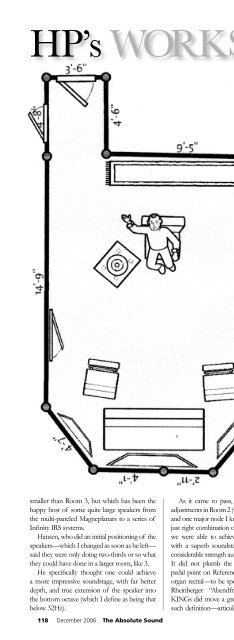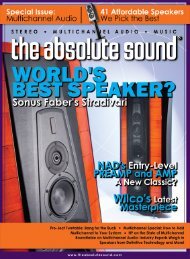You also want an ePaper? Increase the reach of your titles
YUMPU automatically turns print PDFs into web optimized ePapers that Google loves.
HP’s Workshop<br />
smaller than Room 3, but which has been the<br />
happy host of some quite large speakers from<br />
the multi-paneled Magneplanars to a series of<br />
Infinity IRS systems.<br />
Hansen, who did an initial positioning of the<br />
speakers—which I changed as soon as he left—<br />
said they were only doing two-thirds or so what<br />
they could have done in a larger room, like 3.<br />
He specifically thought one could achieve<br />
a more impressive soundstage, with far better<br />
depth, and true extension of the speaker into<br />
the bottom octave (which I define as being that<br />
below 32Hz).<br />
118 December 2006 The Absolute Sound<br />
As it came to pass, with exquisitely careful<br />
adjustments in Room 2 (whose acoustic strengths<br />
and one major node I know oh-so-well), and the<br />
just right combination of associated equipment,<br />
we were able to achieve dramatic results, and<br />
with a superb soundstage and soundfield and<br />
considerable strength audibly flat down to 32Hz.<br />
It did not plumb the depths, e.g., the 16Hz<br />
pedal point on Reference Recordings Felix Hill<br />
organ recital—to be specific, it happens on the<br />
Rheinberger “Abendfriede” cut—but THE<br />
KINGs did move a great deal of air, and with<br />
such definition—articulation—that you’d never<br />
think anything at all was missing.<br />
I want to backtrack a bit. We first used in the<br />
Room 2 setup, the EAR Acute CD player with<br />
the Burmester 04 preamplifier and 911 Mk III<br />
monoblocks (actually stereo amps wired for<br />
mono operation). We switched from a motley<br />
arrangement of interconnects and cables to<br />
an all Nordost Valhalla system, complete with<br />
the company’s superb Thor power-distribution<br />
device and listened that way. In the next phrase,<br />
we inserted an ASR amplifier. We did not bypass<br />
the Burmester preamp, as we could have with<br />
the ASR’s battery-operated input stage, feeding<br />
the EAR directly in. When we did try a bypass,<br />
without the 04 in the system, the ASR, surprisingly,<br />
didn’t sound quite right, and, at the point of this<br />
writing, we still hadn’t isolated whatever gremlin<br />
was causing the eccentricity of the sound.<br />
Then, in the next phase, we warmed up the<br />
Conrad-Johnson Premier 350 solid-state amp<br />
and inserted it in the system. Around this time,<br />
we made final modifications to the speakers’<br />
placement in the room, returning actually to<br />
what I’d called the “classic” position, one that<br />
obeyed what I jokingly call the Pearson Rule<br />
of Thirds (which is not how the speakers were<br />
first placed, nor where they were “re”-placed<br />
by Hansen himself) but this time farther out<br />
into the room, one-third of the way actually,<br />
and moved the speakers closer together until<br />
both were positioned at the one-third points of<br />
the side walls. In a good room, which 2 is, the<br />
Rule of Thirds should always be your starting<br />
point in setting up a system. (See diagram.) By<br />
this time, I knew we were getting extraordinary<br />
results from THE KINGs, and decided to go<br />
one step further. Out went the EAR player and<br />
in came the Lab 47 Pi/Tracer, to my way of<br />
thinking, the very best CD playback system I’ve<br />
yet heard. And the increase in resolution, clarity,<br />
and scarcity of distortion was nothing short of<br />
revelatory. But this did not work to the Premier’s<br />
advantage, since the new setup revealed its<br />
rather soft and slow response in the 30 to 50Hz<br />
region, manifest as a lack of articulation there,<br />
and a subtle but gentle veiling throughout the<br />
frequency range, and a slightly colored sound<br />
that will be familiar to anyone who knows the<br />
Conrad-Johnson’s family “character,” that is, a<br />
mellow almost goldish glow.<br />
So out went the C-J, and back came the<br />
Burmester 911s and the system came “alive”<br />
in a way that belied its less than grandiose<br />
dimensions (at least compared with the Nolas<br />
and other monsters).<br />
So back in went the Burmester amps into<br />
the system now dominated by the Lab 47 player<br />
and repositioned speakers, and the results —<br />
not quite literally, but almost—took my breath<br />
away.










